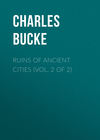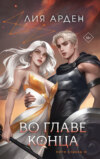Kitabı oxu: «Ruins of Ancient Cities (Vol. 2 of 2)», səhifə 21
NO. XXIX. – SICYON
The most ancient kingdom of Greece was that of Sicyon, the beginning of which is placed by Eusebius 1313 years before the first Olympiad. Its duration is believed to have been about a thousand years; during which period it is said to have had a succession of kings, whose reigns were so equitable that nothing of importance is recorded of them. It sent, however, 3000 troops to the battle of Platea, and fifteen ships to that of Salamis. It is now only a village.
Of these monarchs the most remarkable was Sicyon, who is supposed to have built, though some say he only enlarged, the metropolis of his kingdom, and to have called it by his own name.
It became very powerful in the time of the Achaian league, which it joined, at the persuasion of Aratus, A. C. 251. It was destroyed by Demetrius, son of Antigonus, who afterwards rebuilt it, and endeavoured to impose upon it the name of Demetrius; but it soon sunk under its ancient and more memorable appellation.
Sicyon was in great reputation for the arts, and painting in particular; the true taste for which was preserved there in all its ancient purity. It is even said, that Apelles, who was then admired by all the world, had been at Sicyon, where he frequented the schools of two painters, to whom he gave a talent; not for acquiring a perfection of the art from them, but in order to obtain a share in their great reputation. When Aratus had reinstated his city in its former liberties, he destroyed all the pictures of the tyrants; but when he came to that of Aristratus, who reigned in the time of Philip, and whom the painter had represented in the attitude of standing in a triumphant chariot, he hesitated a long time whether he should deface it or not; for all the capital disciples of Melanthus had contributed to the completion of that piece; and it had even been touched by the pencil of Apelles. This work was so inimitable in its kind, that Aratus was enchanted with its beauties; but his aversion to tyrants prevailed over his admiration of the picture, and he accordingly ordered it to be destroyed.
In the time of Pausanias, Sicyon was destroyed by an earthquake. It was, nevertheless, not long after, not only one of the noblest cities of Greece, on account of its magnificent edifices, many of which were built of marble, and ingenious workmen, but it was a distinguished place when the Venetians were masters of the Morea. The period, however, when it fell from that eminence is unknown.
Sicyon220 was the school of the most celebrated artists of antiquity, and was sumptuously decorated with temples and statues. Pausanias enumerates seventeen temples, a stadium, a theatre, two gymnasia, an agora, a senate-house, and a temenos for the Roman emperors, with many altars, monuments, and numerous statues of ivory and gold, of marble, of bronze, and of wood.
Its present condition, in respect to population, may be, in a great measure, attributed to its having, about twenty years before Sir George Wheler visited it, been afflicted by the plague. “This final destruction,” said one of the inhabitants, “is a judgment of God upon the Turks for turning one of the Christian churches into a mosque. The Vaywode fell down dead upon the place, the first time he caused the Koran to be read in it. This was followed by a plague, which, in a short time, utterly destroyed the whole town; and it could never afterwards be repeopled.”
So little is known221 concerning this ancient seat of Grecian power, that it is not possible to ascertain in what period it dwindled from its pre-eminence to become, what it is now, one of the most wretched villages of the Peloponnesus. The remains of its former magnificence are, however, still considerable, and in some instances they exist in such a state of preservation, that it is evident the buildings of the city either survived the earthquakes said to have overwhelmed them, or they must have been constructed at some later period.
“The ruins of Sicyon,” says Mr. Dodwell, “still retain some vestiges of ancient magnificence. Among these a fine theatre, situate at the north-east foot of the Acropolis; having seats in a perfect state. Near it are some large masses of Roman brick walls, and the remains of the gymnasium, supported by strong walls of polygonal construction. There are several dilapidated churches which, composed of ancient fragments, are supposed to occupy the site of the temples. Several fragments of the Doric order are observable among them; also several inscriptions.”
“In respect to the temple of Bacchus,” says Dr. Clarke, “we can be at no loss for its name, although nothing but the ground-plot now remains. It is distinctly stated by Pausanias to have been the temple of Bacchus, which was placed beyond the theatre to a person coming from the citadel, and to this temple were made those annual processions which took place at night, and by the light of the torches, when the Sicyonians brought hither the mystic images, called Bacchus and Lysius, chanting their ancient hymns.”
The theatre is almost in its entire state; and although the notes were made upon the spot, did not enable Dr. Clarke to afford a description of its form and dimensions equally copious with that already given of the famous theatre of Polycletus in Eidausia; yet this of Sicyon may be considered as surpassing every other in Greece, in the harmony of its proportions, the costliness of the workmanship, the grandeur of the coilon, and the stupendous nature of the prospect presented to all those who were seated upon its benches. If it were cleared of the rubbish about it, and laid open to view, it would afford an astonishing idea of the magnificence of a city, whose treasures were so great, that its inhabitants ranked amongst the most voluptuous and effeminate people of all Greece. The stone-work is entirely of that massive kind, which denotes a very high degree of antiquity.
The stadium222 is on the right hand of a person facing the theatre, and it is undoubtedly the oldest work remaining of all that belonged to the ancient city. The walls exactly resemble those of Mycenæ and Tiryns; we may, therefore, class it among the examples of the Cyclopean masonry. It is, in other respects, the most remarkable structure of the kind existing; combining at once a natural and artificial character. The persons by whom it was formed, finding that the mountain whereon the coilon of the theatre has been constructed, would not allow a sufficient space for another oblong cavea of the length requisite to complete a stadium, built upon an artificial rampart reaching out into the plain, from the mountain toward the sea; so that this front-work resembles half a stadium thrust into the semi-circular cavity of a theatre; the entrance to the area, included between both, being formed with great taste and effect at the two sides or extremities of the semicircle. The ancient masonry appears in the front-work so placed. The length of the whole area equals two hundred and sixty-seven paces; the width of the advanced bastion thirty-six paces; and its height twenty-two feet six inches.
Besides these there are some few other antiquities, but of too minute a kind to merit description.
Even her ruins223 speak less emphatically of the melancholy fate of Greece than her extensive solitudes. Oppression has degraded her children, and broken her spirit. Hence those prodigious plains, which God hath given for their good, are neglected; hence, too, the beauteous seas are without a sail; the lands of ancient Sicyon so thinly peopled!
’Tis Greece, but living Greece no more!
So coldly sweet, so deadly fair,
We start – for soul is wanting there!
Hers is the loveliness in death,
That parts not quite with parting breath;
But beauty with that fearful bloom,
That hue which haunts it to the tomb —
Expression’s last receding ray,
A gilded halo, hovering round decay,
The farewell beam of feeling past away;
Spark of that flame, perchance of heavenly birth,
Which gleams, but warms no more its cherished earth!224
NO. XXX. – SIDON
Phœnicia comprised Sidon, Tyre, Ptolemais, and Berytus. Its mountains were Libanus and Anti-Libanus. Its most ancient city was Sidon; which was an opulent city even at so early a period as that in which the Greeks are said to have lived upon acorns. It is situated on the shores of the Mediterranean, at a distance of about twenty miles from Tyre, and fifty from Damascus.
Sidon is supposed to have been built by Canaan’s first-born, whose name was Sidon225. It is, therefore, celebrated as the most ancient of the cities of Phœnicia. It is frequently mentioned in holy writ. It is named by Jacob226, in his prophetic speech concerning the country which his sons were to inhabit; and it is stated as a place for some of the kings who were driven out by Joshua. Its remote origin, however, is perhaps still uncertain, though Justin speaks of it in the following manner: – “The nation of the Tyrians, descended from the Phœnicians, being shaken by an earthquake, and having abandoned their country, did first inhabit the Assyrian marsh; and, not long afterwards, the shore next unto the sea, where they built a city, and called it Sidon, from the abundance of fishes that were there: for the Phœnicians call a fish sidon. After the process of many years, being overcome by king Ascalon, they took shipping again, and built Tyre in the year before the destruction of Troy.”
“I cannot help thinking,” says Mr. Drummond, “that the city, called Tsidon by the Hebrews; Tsaid or Tsaida, by the Syrians; and Said or Saida, by the Arabians; originally received its name from the language of the last. The Tsidonians were celebrated for their skill in metallurgy, and for the art with which they worked in gold, silver, and brass. Much iron and brass existed in Phœnicia, and the possession of this country having been once intended for the tribe of Ashur, Moses said to that tribe, ‘under thy shoes shall be iron and brass:’ (Deut. xxxiii. 25.): that is, the soil under thy feet shall abound with iron and brass. Now I consider Sidon, or rather Saida, to have been so called from its abounding with saidi or saidan, viz. brass.”227
During the administration of Joshua, and afterwards, Sidon was governed by kings. He calls it “Zidon the great.”228 In the division of Palestine it was allotted to Ashur; but this tribe could never get possession of it.229
The inhabitants are said to have assisted Solomon, in his preparations for the building of the temple; their skill in hewing timber being superior to that of all other nations.230
That Sidon was celebrated for its women being skilled in embroidery, we learn, in the first instance, from several passages in Scripture; and secondly, from a curious passage in Homer:
The Phrygian queen to her rich wardrobe went,
Where treasured odours breathed a costly scent.
There lay the vestures of no vulgar art,
Sidonian maids embroider’d every part,
Whom from soft Sidon youthful Paris bore,
With Helen touching on the Tyrian shore.
Here as the queen revolved with careful eyes
The various textures and the various dyes,
She chose a veil that shone superior far,
And glow’d refulgent as the morning star.231
To the Sidonians, also, are attributed the inventions of glass,232 linen, and purple dye. They were also greatly celebrated for their industry. They were highly commercial, and were famous for the many voyages some of their fellow-citizens undertook. It was the most ancient of maritime cities: illustrious for its wealth, for the sobriety and industry of its inhabitants; for the wisdom of its councils, and for its skill, not only in commerce and geography, but in astronomy.
The Sidonians were often engaged in war; but we can afford space only to a few instances. The origin of that with Artaxerxes Ochus, is thus related by Diodorus:233– “The king’s lieutenants and generals then in Sidon, carrying themselves, by their severe edicts, rigorously and haughtily towards the Sidonians, the citizens, being so abused, and not being able longer to brook it, studied how to revolt from the Persians. Upon which, the rest of the Phœnicians, being wrought upon by the others to vindicate their liberty, sent messengers to Nectanetus, the king of Egypt, then at war with the Persians, to receive them as confederates, and so the whole nation (Phœnicia,) prepared for war. And being that Sidon exceeded all the rest of the cities in wealth, and even private men, by the advantage of trade, were grown very rich, they built a great number of ships, and raised a potent army of mercenaries; and both arms, and darts, and provisions, and all other things necessary for war were prepared; and that they might appear first in the war, they spoiled and ruined the king’s garden, cutting down all the trees, where the Persian kings used to recreate and divert themselves. Then they burned all the hay, which the lieutenants had laid up for the horses. At last they seized upon the Persians, who had so insulted them, and led them to punishment, and in this manner began the war of the Persians with the Phœnicians.”
Ochus Artaxerxes acted in a manner so contrary to all the best notions of government, that some historians have not hesitated to regard him as the most cruel and wicked of all the princes of his race. Not only the palace, but the empire was filled with his murderers. Several nations, over whom he exercised sway, in consequence revolted. Amongst these, Sidon and the other Phœnician cities. Ochus hearing of this, resolved to go in person to reduce the rebels. He repaired to Phœnicia with an army of 300,000 foot, and 30,000 horse. Mentor was at this time in Sidon with some troops from Greece. He had come thither to assist the rebels. When he learned how great a force the Persian king had, he was so alarmed, that he sent secretly to the king to offer to deliver up Sidon. This offer Ochus accepted; and the king of Sidon having come into the treason, the city was surrendered into his hands.
When the Sidonians saw themselves betrayed, and that the enemy had got entire possession of their city, they gave themselves up to despair, shut themselves up in their houses, and set them on fire. In this manner 40,000 men, besides women and children, perished in the flames! At this time, Sidon was so immensely rich, that the cinders, among which a vast quantity of gold and silver had melted, were sold by the conqueror for a large sum of money.
This judgment had been prophesied by Ezekiel234.
“20. Again the word of the Lord came unto me, saying,
“21. Son of man, set thy face against Zidon, and prophesy against it.
“22. And say, Thus saith the Lord God; Behold I am against thee, O Zidon; and I will be glorified in the midst of thee: and they shall know that I am the Lord, when I shall have executed judgments in her, and shall be sanctified in her.
“23. For I will send into her pestilence, and blood into her streets; and the wounded shall be judged in the midst of her by the sword upon her on every side; and they shall know that I am the Lord.”
Eighteen years after this misfortune, Alexander of Macedon marched into Phœnicia. All submitted to him as he advanced; nor did any people do this with greater alacrity than the Sidonians: who, having suffered so largely from the Persian king, held the Persians in very great detestation. Strato, their king, however, having declared for Darius, Alexander desired Hephæstion to place in his stead any one of the Sidonians that he should judge worthy of so exalted a station. Being quartered at the house of two brothers, of whom he had reason to entertain the highest opinion, Hephæstion offered the crown to them; but these brothers had the virtue to refuse it, telling him, that, by the laws of the country, no one could ascend the throne but those who were of the blood-royal. Hephæstion, greatly moved at seeing the greatness of those who could refuse what so many others had striven to obtain by fire and sword, expressed his admiration of their magnanimity; and desired them to name any person of the royal family who would, on being placed upon the throne, remember who it was that put him there. On this the brothers answered, that they knew of no one more worthy of a diadem than a person, named Abdolonymus. He was, they said, of the royal family, though at a great distance from the succession; but so poor that he was compelled to earn his bread by working in one of the gardens outside the city. He was not only poor, they continued, but of so contented a spirit, of so exalted a mind, and of such deep engagement of purpose, that the wars, which were then shaking Asia, were altogether unknown to him.
The two brothers immediately repaired to the place where they knew this person was to be found. They took royal garments with them; and after no great search found him employed in weeding his garden. They immediately saluted him as King of Sidon. “You must change your tatters,” said one of the brothers, “for the royal garments we have brought with us. Put off that mean and contemptible habit, in which you have grown old. Assume the style and sentiments of a prince. When, however, you are seated on the throne, continue to preserve the virtues which have made you worthy of it.” When Abdolonymus heard this, he was amazed. He looked upon the whole as a dream. When, however, he perceived that the two brothers were standing before him in actual presence, he inquired of them if they did not feel some shame in ridiculing him in that manner? They replied, that no ridicule was intended; but that all was in the spirit of honour. They threw over his shoulders a purple raiment, richly embroidered with gold; repeated to him oaths of earnestness, and led him to the palace.
The news of this astonishing circumstance soon spread over the whole city. Most of the richer sort were indignant. Alexander, however, commanded that the newly elected prince should be brought into his presence. When he was presented, Alexander measured him with his eye from head to foot, and gazed upon his countenance for some time. At length he addressed him after the following manner: – “Thine air and thy mien by no means contradict what I have heard, in regard to thy extraction; and I therefore desire to know in what spirit thou hast borne the abject condition to which thou wert reduced.” “Would to the gods,” answered Abdolonymus, “that I may bear this crown with equal patience! These hands have procured to me all I have enjoyed; for whilst I had nothing, I wanted nothing.”
When Alexander heard this, he was so struck with admiration, that he not only presented him with all the furniture that had belonged to Strato, and part of the riches he had himself acquired in Persia, but he annexed to his dominions one of the neighbouring provinces.
At this period, Quietus Curtius says235, Sidon was a city greatly celebrated on account of its antiquity and its founder.
Upon an elevation, on the south side of the city, stood a fine old castle, now in ruins. It was built by Lewis IX. of France, surnamed the Saint; who also repaired the city during the Holy Wars236. In subsequent times it fell into decay; but its final ruin is said to have been effected by Feckerdine, Emir of the Druses, when he had established an independent power, with the view of preventing the Grand Signior from landing a maritime force here to act against him. He destroyed all the little ports, from Bairout to Acra, by sinking boats and stones to prevent the Turkish ships from entering them237. He then built a castle, which still exists. He erected also a magnificent palace in the Italian style; but that is in ruins.
In the time of Volney, Sayda contained about five thousand inhabitants; in 1816 from six thousand to seven thousand. Of these there are one thousand Christians, five hundred Jews, the rest are Mahommedans. The climate is mild, agreeable, and healthy.
The huge stones of which the mole was built may still be seen, being capable of filling its whole thickness. Some of these are twelve feet long, eleven broad, and five deep. It is supposed to have been built by Lewis IX.; but this, perhaps, was not the case, since it contains, on the top of it, a work of a much more ancient date.
On the opposite side of the town is a modern fort, built by Degnizlu; but consisting merely of a large tower, incapable of resisting any serious attack.
“Sidon was the mother of Tyre,” says Mr. Robinson; “yet it was speedily eclipsed by that city, in fame, in riches, and in importance. After sharing in its fortunes, during the space of many centuries, it has finally survived its rival, and is again a place of considerable trade.”
The buildings of Sayda, according to Mr. Buckingham, are not at all superior to the common order of Mahommedan edifices in the modern towns of Syria. The streets are extremely narrow, the mosques mean, the caravanserais small and incommodious, and the bazaars few, and badly furnished even with the commonest necessaries. According to another traveller, Sayda is ill-built, dirty, and full of ruins. These ruins, however, are of a comparatively modern date. Few of ancient times remain. There is, nevertheless, a large tesselated pavement of variegated marble, representing a horse, and tolerably perfect in some parts for ten feet in length, remaining close to the sea, on the northern extremity of the city, which shows that the sea encroaches on the land. There are also several columns of granite wrought into the walls; and some stand as posts on the bridge leading to the fort; and near the gate of the town is a small square building, which contains the tombs of such of the Emirs of the Druses as died when Sayda was in their possession.
Sayda is the principal port of Damascus. The harbour, like all those on this coast, was formed with much art, and at an immense expense, by means of long piers. These works, which subsisted entire under the lower empire, are now fallen into decay. “So great are the mutations, occasioned by time,” says Mr. Buckingham, “that but for the identity of name and position, there would be scarcely any marks left by which to recognise even the site of the present emporium here alluded to. The stranger, who visits it in its present state, will look around in vain for any of those vestiges of its former grandeur which the description of the ancient historians would lead him to expect; and which, indeed, are still to be seen in most of the other celebrated cities of the East, – whether in Greece, Egypt, Syria, or Asia Minor.238”










